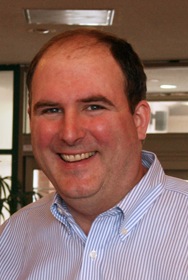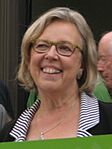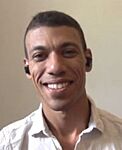Green Party of Canada facts for kids
Quick facts for kids
Green Party of Canada
Parti vert du Canada
|
|
|---|---|
 |
|
| Leader | |
| Deputy leader | Angela Davidson |
| President | Vincent J. Carbonneau |
| Executive Director | Paul Manly |
| Founded | 4 November 1983 |
| Headquarters | 116 Albert Street Suite 812 Ottawa, Ontario |
| Youth wing | Young Greens of Canada |
| Membership (2025) | |
| Ideology | |
| Continental affiliation | Federation of the Green Parties of the Americas |
| International affiliation | Global Greens |
| Colours | Green |
| Senate |
0 / 105
|
| House of Commons |
1 / 343
|
The Green Party of Canada (also known as French: Parti vert du Canada) is a political party in Canada. It was started in 1983 and focuses on green politics, which means caring for the environment.
The Green Party is currently the fifth largest party in the House of Commons. This is where elected representatives from across Canada meet to make laws. The party elected its first Member of Parliament (MP), Elizabeth May, in the 2011 election. She won in the area called Saanich—Gulf Islands.
In the 2019 election, the party had three MPs. In the 2021 election, they had two MPs. In the 2025 election, the party had one MP.
Elizabeth May was the party leader from 2006 to 2019. She became leader again on November 19, 2022. On February 4, 2025, the party decided to have two leaders at once. Elizabeth May and Jonathan Pedneault became the first co-leaders.
The Green Party is built on six main ideas: ecological wisdom (being smart about nature), non-violence, social justice (fairness for everyone), sustainability (using resources wisely for the future), participatory democracy (everyone having a say), and respect for diversity.
Contents
History of the Green Party
The idea for an environmentally focused political party in Canada began in the early 1980s. A group of candidates, including Elizabeth May, ran in the 1980 federal election. They wanted to move towards a society that used less nuclear power and conserved resources.
The Green Party of Canada was officially started at a meeting in Ottawa on November 4, 1983. Its first leader was Trevor Hancock. In the 1984 Canadian federal election, the party had 60 candidates running for election.
Over the years, the party grew. In 1990, the Quebec branch of the party hosted a big conference. However, some Quebec candidates later left to join a party focused on Quebec's independence.
Joan Russow's Leadership
Joan Russow from British Columbia became the leader of the Green Party of Canada on April 13, 1997. She won the leadership race with 52% of the votes. Soon after, a federal election was called.
In the 1997 Canadian federal election, Russow's campaign was important because it was the first time the Greens had a national leader's tour and a national plan. This helped the party become more organized across the country.
In 1998, the party made a rule that members could not also be members of other federal political parties. This was to prevent other parties from trying to take over the Green Party.
The party continued to grow. In the 2000 Canadian federal election, they had 111 candidates, which was more than in 1997.
Jim Harris and Growing Support
In February 2003, Jim Harris became the leader of the Green Party. This was his second time trying for the leadership.
During the 2004 Canadian federal election, the Green Party of Canada made history. It became the fourth federal political party to have candidates running in every single area (called "ridings") across Canada. The party received 4.3% of all the votes. This was important because it meant they got money from the government to help fund their party, based on new rules from Elections Canada.
The party continued to gain support. In the 2006 Canadian federal election, they again had 308 candidates and increased their share of the votes to 4.5%. This meant they continued to receive federal funding.
Elizabeth May Becomes Leader
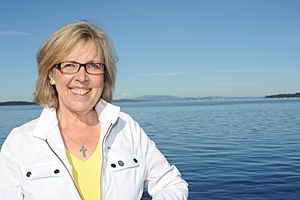
In August 2006, the party held a vote for a new leader. Jim Harris had decided not to run again. Elizabeth May won the leadership with 65% of the votes.
On October 22, 2006, Elizabeth May ran in a special election in London North Centre, Ontario. She came in second place, getting 26% of the votes.
Even though the Green Party had never won a seat in Parliament, Elizabeth May's leadership helped them get more attention from the media. People started to notice their ideas on other topics, not just the environment.
On August 30, 2008, Blair Wilson, an MP from Vancouver, became the first Green Member of Parliament. He had been a Liberal MP but decided to join the Green Party. He joined during the summer break and never sat in the House of Commons as a Green MP.
For the first time, Elizabeth May was invited to participate in the leaders' debates during the 2008 Canadian federal election. This was a big step for the party. In that election, the party's share of the votes increased to 6.80%. However, they still did not elect any candidates.
Greens in Parliament
On May 2, 2011, Elizabeth May made history by becoming the first elected Green Party MP to sit in the House of Commons. She won her seat in Saanich—Gulf Islands in British Columbia. This was a big achievement, as it's rare for Green Party members to be elected in single-seat elections around the world.
On December 13, 2013, Bruce Hyer, an MP from Thunder Bay—Superior North, joined the Green Party. He had left the New Democratic Party (NDP) to become an independent MP. With Hyer joining, the Green Party had two MPs in Parliament for the first time.
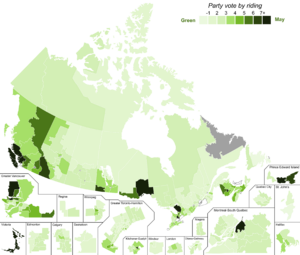
In the 2015 Canadian federal election, Elizabeth May was re-elected in Saanich—Gulf Islands. However, both Bruce Hyer and José Núñez-Melo (who had also joined the Greens before the election) were not re-elected. This left Elizabeth May as the only Green MP in the House of Commons.
In March 2018, Elizabeth May appointed Jo-Ann Roberts and Daniel Green as deputy leaders.
On May 6, 2019, Paul Manly became the second MP elected under the Green Party banner. He won a special election in Nanaimo—Ladysmith. On August 19, 2019, Pierre Nantel, a former NDP MP, also joined the Green Party.
During the 2019 Canadian federal election, Elizabeth May and Paul Manly were both re-elected. Also, Jenica Atwin was elected in her riding of Fredericton in New Brunswick. This made her the third elected Green MP and the first Green MP elected outside of British Columbia.
In the 2021 Canadian federal election, Mike Morrice was elected in Kitchener Centre. He became the first Green MP elected in Ontario and the second Green MP outside of British Columbia. Elizabeth May was also re-elected. However, Paul Manly was not re-elected, and Jenica Atwin won her election as a Liberal candidate.
Annamie Paul's Leadership

On November 4, 2019, Elizabeth May announced she would step down as leader. She continued to be the Green MP in Parliament. A new leadership election was held on October 3, 2020. Annamie Paul, a lawyer and activist from Toronto, was chosen to be the new leader.
Annamie Paul ran in a special election in Toronto Centre and came in second place.
On June 10, 2021, Jenica Atwin left the Green Party to join the Liberal Party. This happened after some disagreements within the Green Party. After the 2021 Canadian federal election, where the party's vote share dropped, Annamie Paul announced she would resign as leader.
Annamie Paul officially resigned on November 10, 2021.
Rebuilding the Party
On November 24, 2021, Amita Kuttner was appointed as the interim leader. At 30 years old, Kuttner was the youngest person to lead a federal political party in Canada. Kuttner was also the first transgender person and person of East Asian heritage to lead a federal party.
Kuttner focused on helping the party recover and grow again. The party had faced financial challenges and lost members due to internal disagreements. Kuttner worked to improve the party's financial situation.
On September 11, 2022, the party's president, Lorraine Rekmans, resigned.
Elizabeth May Returns as Co-Leader
On November 19, 2022, Elizabeth May was elected leader of the party again. She had promised to change the leadership model to have two leaders. Jonathan Pedneault ran with her in the leadership race and became the deputy leader.
On February 4, 2025, the party members approved the idea of having co-leaders. Jonathan Pedneault officially became co-leader with Elizabeth May. The party also revealed a new logo on February 18, 2025, which was their first new logo in 25 years.
On April 16, 2025, Jonathan Pedneault spoke to the media after the Green Party was not invited to a leaders' debate. The Leaders' Debate Commission said the party had reduced its number of candidates, which went against the idea of a national debate. Pedneault called this decision "undemocratic." In the 2025 Canadian federal election, the party won only one seat (Saanich—Gulf Islands) and had a smaller share of the popular vote. Jonathan Pedneault resigned as co-leader two days after the election.
Green Party Ideas and Goals
The Green Party believes that the old ideas of "left" and "right" in politics are not as important anymore. Instead, they think that people are divided by whether they are "insiders" or "outsiders" in society.
The party believes that we cannot keep using more and more of Earth's resources. They think we need to share the Earth's limited resources more fairly. In 2019, the Green Party's slogan was "Not Left. Not Right. Forward Together."
The Green Party has different groups of people with various ideas within it. Some members are more moderate, while others have more socialist views. Many people see the Green Party as a party that cares about social issues and fairness, while also looking for new ways to solve problems.
Six Key Principles
The Green Party of Canada is based on six important ideas that were agreed upon by Green parties around the world in 2002. These ideas are:
- Ecological wisdom: Being smart and careful about how we treat nature and the environment.
- Non-violence: Solving problems peacefully without using force.
- Social justice: Making sure everyone is treated fairly and has equal opportunities.
- Sustainability: Using resources in a way that meets our needs now without harming the ability of future generations to meet their own needs.
- Participatory democracy: Giving more power to regular people to make decisions, not just politicians.
- Respect for diversity: Valuing and celebrating all the different kinds of people and cultures in the world.
Green Members of Parliament
Here are some of the people who have been Green Members of Parliament:
| Name | Riding | Province/territory | MP from | MP until | Predecessor | Joined Green Caucus |
|---|---|---|---|---|---|---|
| Mike Morrice | Kitchener Centre | Ontario | September 20, 2021 | March 23, 2025 | Raj Saini | No |
| Jenica Atwin | Fredericton | New Brunswick | October 21, 2019 | March 23, 2025 | Matt DeCourcey | Yes, left caucus (to Liberals) |
| Paul Manly | Nanaimo—Ladysmith | British Columbia | May 6, 2019 | September 20, 2021 | Sheila Malcolmson | No |
| Bruce Hyer | Thunder Bay—Superior North | Ontario | October 14, 2008 | August 4, 2015 | Joe Comuzzi | Yes, joined caucus (from NDP) |
| Elizabeth May | Saanich—Gulf Islands | British Columbia | May 2, 2011 | present | Gary Lunn | No |
| Blair Wilson | West Vancouver—Sunshine Coast—Sea to Sky Country | British Columbia | January 23, 2006 | October 14, 2008 | John Reynolds | Yes, joined caucus (from Liberals) |
Members Who Joined After Parliament Ended
Some MPs joined the Green Party after Parliament was officially ended for an election. This means they were never formally recorded as Green MPs in the House of Commons.
| Name | Riding | Province/territory | MP from | MP until | Predecessor | Joined Green Caucus |
|---|---|---|---|---|---|---|
| José Núñez-Melo | Laval | Quebec | May 2, 2011 | October 19, 2015 | Nicole Demers | Yes, joined after parliament dissolved (from NDP) |
| Pierre Nantel | Longueuil—Saint-Hubert | Quebec | May 2, 2011 | October 21, 2019 | Jean Dorion | Yes, joined after parliament dissolved (from NDP) |
Party Leaders
Here is a list of the leaders of the Green Party of Canada:
| Leader | Term start | Term end |
|---|---|---|
| Trevor Hancock | 1983 | 1984 |
| Seymour Trieger | 1984 | 1988 |
| Kathryn Cholette | 1988 | 1990 |
| Chris Lea | 1990 | 1996 |
| Wendy Priesnitz | 1996 | 1997 |
| Harry Garfinkle (interim) | 1997 | 1997 |
| Joan Russow | 1997 | 2001 |
| Chris Bradshaw (interim) | 2001 | 2003 |
| Jim Harris | 2003 | 2006 |
| Elizabeth May | 2006 | 2019 |
| Jo-Ann Roberts (interim) | 2019 | 2020 |
| Annamie Paul | 2020 | 2021 |
| Amita Kuttner (interim) | 2021 | 2022 |
| Elizabeth May | 2022 | present |
| Jonathan Pedneault | 2025 | 2025 |
Election Results in the House of Commons
This table shows how the Green Party has done in federal elections for the House of Commons:
| Election | Leader | Votes | % | Seats | +/– | Position | Status |
|---|---|---|---|---|---|---|---|
| 1984 | Trevor Hancock | 26,921 | 0.21 |
0 / 282
|
No seats | ||
| 1988 | Seymour Trieger | 47,228 | 0.36 |
0 / 295
|
No seats | ||
| 1993 | Chris Lea | 32,979 | 0.24 |
0 / 295
|
No seats | ||
| 1997 | Joan Russow | 55,583 | 0.43 |
0 / 301
|
No seats | ||
| 2000 | 104,402 | 0.81 |
0 / 301
|
No seats | |||
| 2004 | Jim Harris | 582,247 | 4.32 |
0 / 308
|
No seats | ||
| 2006 | 665,940 | 4.48 |
0 / 308
|
No seats | |||
| 2008 | Elizabeth May | 941,097 | 6.78 |
0 / 308
|
No seats | ||
| 2011 | 576,221 | 3.91 |
1 / 308
|
No status | |||
| 2015 | 605,637 | 3.45 |
1 / 338
|
No status | |||
| 2019 | 1,189,607 | 6.55 |
3 / 338
|
No status | |||
| 2021 | Annamie Paul | 397,014 | 2.33 |
2 / 338
|
No status | ||
| 2025 | Elizabeth May & Jonathan Pedneault |
240,607 | 1.2 |
1 / 343
|
No status |
Green Parties in Provinces and Territories
Nine provinces in Canada have their own Green parties. While these provincial parties share similar values with the Green Party of Canada, they are separate groups. They do not have the same members.
Currently, nine Green politicians are elected in provincial governments. Three are in Prince Edward Island, two in British Columbia, two in New Brunswick, and two in Ontario. The Greens in Prince Edward Island were the first Green party to become the official opposition in any provincial government.
The only province without a Green party is Newfoundland and Labrador. There have been efforts to start a provincial Green party there.
Nunavut and the Northwest Territories have different types of governments that do not use political parties. So, there are no registered Green parties there. However, some members of their governments might also be members of the federal Green Party.
See also
 In Spanish: Partido Verde de Canadá para niños
In Spanish: Partido Verde de Canadá para niños


